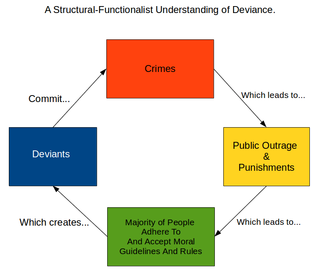Related Research Articles
A mental disorder, also referred to as a mental illness or psychiatric disorder, is a behavioral or mental pattern that causes significant distress or impairment of personal functioning. A mental disorder is also characterized by a clinically significant disturbance in an individual's cognition, emotional regulation, or behavior. It is usually associated with distress or impairment in important areas of functioning. There are many different types of mental disorders. Mental disorders may also be referred to as mental health conditions. Such features may be persistent, relapsing and remitting, or occur as single episodes. Many disorders have been described, with signs and symptoms that vary widely between specific disorders. Such disorders may be diagnosed by a mental health professional, usually a clinical psychologist or psychiatrist.
Pathological jealousy, also known as morbid jealousy, Othello syndrome, or delusional jealousy, is a psychological disorder in which a person is preoccupied with the thought that their spouse or sexual partner is being unfaithful without having any real proof, along with socially unacceptable or abnormal behaviour related to these thoughts. The most common cited forms of psychopathology in morbid jealousy are delusions and obsessions. It is considered a subtype of delusional disorder.
Forensic psychology is the practice of psychology applied to the law. Forensic psychology is the application of scientific knowledge and methods to help answer legal questions arising in criminal, civil, contractual, or other judicial proceedings. Forensic psychology includes research on various psychology-law topics, such as jury selection, reducing systemic racism in criminal law, eyewitness testimony, evaluating competency to stand trial, or assessing military veterans for service-connected disability compensation. The American Psychological Association's Specialty Guidelines for Forensic Psychologists reference several psychology subdisciplines, such as social, clinical, experimental, counseling, and neuropsychology.
Criminal psychology, also referred to as criminological psychology, is the study of the views, thoughts, intentions, actions and reactions of criminals and suspects. It is a subfield of criminology and applied psychology.

Forensic psychiatry is a subspeciality of psychiatry and is related to criminology. It encompasses the interface between law and psychiatry. According to the American Academy of Psychiatry and the Law, it is defined as "a subspecialty of psychiatry in which scientific and clinical expertise is applied in legal contexts involving civil, criminal, correctional, regulatory, or legislative matters, and in specialized clinical consultations in areas such as risk assessment or employment." A forensic psychiatrist provides services – such as determination of competency to stand trial – to a court of law to facilitate the adjudicative process and provide treatment, such as medications and psychotherapy, to criminals.
Park Elliot Dietz is a forensic psychiatrist who has consulted or testified in many of the highest profile US criminal cases, including spousal killer Betty Broderick, mass murderer Jared Lee Loughner, and serial killers Joel Rifkin, Arthur Shawcross, Jeffrey Dahmer, Ted Kaczynski, Richard Kuklinski, the D.C. sniper attacks, and William Bonin.

Emergency psychiatry is the clinical application of psychiatry in emergency settings. Conditions requiring psychiatric interventions may include attempted suicide, substance abuse, depression, psychosis, violence or other rapid changes in behavior.

The Mental Health Act 1983 is an Act of the Parliament of the United Kingdom. It covers the reception, care and treatment of mentally disordered people, the management of their property and other related matters, forming part of the mental health law for the people in England and Wales. In particular, it provides the legislation by which people diagnosed with a mental disorder can be detained in a hospital or police custody and have their disorder assessed or treated against their wishes, informally known as "sectioning". Its use is reviewed and regulated by the Care Quality Commission. The Act was significantly amended by the Mental Health Act 2007. A white paper proposing changes to the act was published in 2021 following an independent review of the act by Simon Wessely.
The Threat Management Unit (TMU) is the threat management unit of the Los Angeles Police Department (LAPD), tasked with investigating harassment and stalking, especially against celebrities and officials. The TMU was formed in 1990 after the murder of actress Rebecca Lucile Schaeffer. Over the years the TMU has been visited and emulated by law enforcement agencies and security companies across the United States and the world.

Suicidal ideation, or suicidal thoughts, is the thought process of having ideas, or ruminations about the possibility of ending one's own life. It is not a diagnosis but is a symptom of some mental disorders, use of certain psychoactive drugs, and can also occur in response to adverse life events without the presence of a mental disorder.
Suicide risk assessment is a process of estimating the likelihood for a person to attempt or die by suicide. The goal of a thorough risk assessment is to learn about the circumstances of an individual person with regard to suicide, including warning signs, risk factors, and protective factors. Risk for suicide is re-evaluated throughout the course of care to assess the patient's response to personal situational changes and clinical interventions. Accurate and defensible risk assessment requires a clinician to integrate a clinical judgment with the latest evidence-based practice, although accurate prediction of low base rate events, such as suicide, is inherently difficult and prone to false positives.
Celebrity worship syndrome (CWS) or celebrity obsession disorder (COD) is an obsessive addictive disorder in which a person becomes overly involved with the details of a celebrity's personal and professional life. Psychologists have indicated that though many people obsess over film, television, sport and pop stars, the only common factor between them is that they are all figures in the public eye. Written observations of celebrity worship date back to the 19th century.

Forensic social work is the application of social work to questions and issues relating to the law and legal systems. It is a type of social work that involves the application of social work principles and practices in legal, criminal, and civil contexts. It is a specialized branch of social work that focuses on the intersection of law and mental health. Forensic social work is an important part of the criminal justice system and provides an important link between mental health and the legal system.
A psychiatric assessment, or psychological screening, is the process of gathering information about a person within a psychiatric service, with the purpose of making a diagnosis. The assessment is usually the first stage of a treatment process, but psychiatric assessments may also be used for various legal purposes. The assessment includes social and biographical information, direct observations, and data from specific psychological tests. It is typically carried out by a psychiatrist, but it can be a multi-disciplinary process involving nurses, psychologists, occupational therapist, social workers, and licensed professional counselors.
Stalking is unwanted and/or repeated surveillance by an individual or group toward another person. Stalking behaviors are interrelated to harassment and intimidation and may include following the victim in person or monitoring them. The term stalking is used with some differing definitions in psychiatry and psychology, as well as in some legal jurisdictions as a term for a criminal offense.
In United States civilian law enforcement, a Threat Management Unit is a police department team that provides criminal and behavioral analysis and risk assessments in an attempt to review, and ultimately mitigate, the potential for violence with an emphasis on prevention. Threat Management Units identify risk factors, patterns of escalation, and construct an environment that inhibits or prevents violence. The services provided cover a wide range of topics, including, but not limited to terrorism, school violence, sexual crimes, stalking, cyber crimes, domestic violence, arson, sabotage, communicated threats, insider threats and pre-attack behavior. Research in this area of law enforcement is known as Threat Safety Science.
The following outline is provided as an overview of and topical guide to psychiatry:
Barnet, Enfield and Haringey Mental Health NHS Trust (BEH) is a large provider of integrated mental health and community health services in North London, providing services across Barnet, Enfield, and Haringey. The trust currently employs around 3,000 staff and serves a population of just over a million. The annual income in 2017-18 was c. £210 million.
Threat assessment is the practice of determining the credibility and seriousness of a potential threat, as well as the probability that the threat will become a reality. Threat assessment is separate to the more established practice of violence-risk assessment, which attempts to predict an individual's general capacity and tendency to react to situations violently. Instead, threat assessment aims to interrupt people on a pathway to commit "predatory or instrumental violence, the type of behavior associated with targeted attacks," according to J. Reid Meloy, PhD, co-editor of the International Handbook of Threat Assessment. "Predatory and affective violence are largely distinctive modes of violence."
Urban Metcalf was a clothes salesman and asylum patient who was arrested for allegedly attempting to assassinate King George III. Metcalf went in and out of various asylums for his entire adult life before eventually being permanently committed to York asylum in 1822. Metcalf reportedly believed that he was King, based on a 'delusional genealogy', and repeatedly tried to enter royal palaces.
References
- ↑ James DV; Mullen PE; Meloy JR; Pathe´ MT; Farnham FR; Preston L; Darnley B (2007). "The role of mental disorder in attacks on European politicians 1990–2004" (PDF). Acta Psychiatrica Scandinavica. 116 (5): 334–344. doi:10.1111/j.1600-0447.2007.01077.x. PMID 17919154. S2CID 3151898. Archived from the original (PDF) on 26 July 2011. Retrieved 23 September 2010.
- ↑ David James; Paul E. Mullen; Michele T. Pathe´; J. Reid Meloy; Frank R. Farnham; Lulu Preston; Brian Darnley (2007). "Attacks on the British Royal Family - The Role of Psychotic Illness". Journal of the American Academy of Psychiatry and the Law.
- ↑ David James; Paul E. Mullen; Michele T. Pathe´; J. Reid Meloy; Lulu Preston; Brian Darnley; Frank R. Farnham (2009). "Stalkers and harassers of royalty: the role of mental illness and motivation" (PDF). Psychological Medicine. Archived from the original (PDF) on 26 July 2011. Retrieved 23 September 2010.
- ↑ Park Dietz; Daniel Martell (2010). "Commentary – Approaching and stalking public figures – a prerequisite to attack". Journal of the American Academy of Psychiatry and the Law.
- 1 2 Paul E. Mullen; David James; J. Reid Meloy; Michele T. Pathe´; Frank R. Farnham; Lulu Preston; Brian Darnley; Jeremy Berman (2009). "The fixated and the pursuit of public figures". Journal of Forensic Psychiatry & Psychology.
- ↑ "Fixated Threat Assessment Centre - Hansard". hansard.parliament.uk. Retrieved 18 November 2020.
- ↑ Chris Summers (16 September 2010). "How do the police keep an eye on VIP stalkers?". BBC News.
- ↑ Joanna Bale (27 May 2007). "VIP 'stalker' squad set up by government". The Times.
- 1 2 3 James, D.; Kerrigan, T.; Forfar, R.; Farnham, F.; Preston, L. (2010). "The Fixated Threat Assessment Centre: preventing harm and facilitating care". Journal of Forensic Psychiatry & Psychology. 21 (4): 1. doi:10.1080/14789941003596981. S2CID 59398233.
- ↑ "Daily Hansard - Written Answers - 25 Jun 2007 : Column 301W". Archived from the original on 19 August 2012. Retrieved 19 July 2010.
- 1 2 "Column 875W". publications.parliament.uk. 10 June 2009. Retrieved 7 January 2022.
- ↑ David James (2010). "Protecting the prominent? A research journey with Paul Mullen". Criminal Behaviour and Mental Health. 20 (3): 242–250. doi: 10.1002/cbm.769 . PMID 20549786.
- ↑ Park Elliott Dietz; Daniel Allen Martell (1989). "Mentally disordered offenders in pursuit of celebrities and politicians".
- ↑ Paul Mullen; Michele Pathé; Rosemary Purcell (2009). "Stalkers and their Victims, 2nd edition". Cambridge University Press.
- ↑ J Reid Meloy (1998). "The Psychology of Stalking". Academic Press.